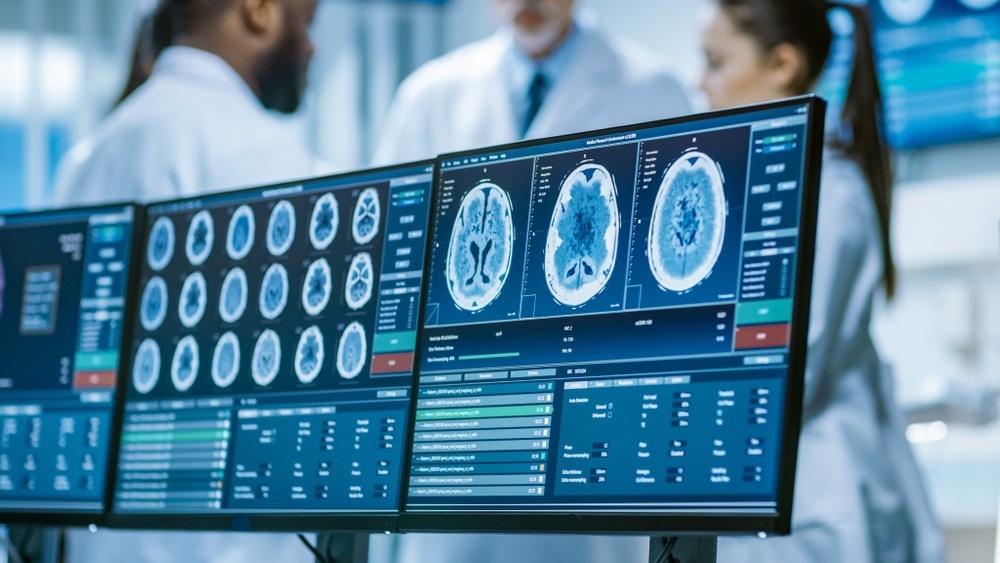Reviewed by Danielle Ellis, B.Sc.Dec 13 2023
A group of researchers has introduced a set of free tools designed for analyzing extensive collections of brain dissection images from brain banks worldwide.

Image Credit: Gorodenkoff/Shutterstock.com
The aim is to enhance the comprehension of neurodegenerative diseases. The findings, featured in a Reviewed Preprint in eLife today, present a valuable open-source resource for professionals in the fields of neuropathology and neuroimaging.
The study is supported by compelling evidence derived from experiments utilizing both genuine and synthetic data.
Understanding aging and neurodegenerative conditions often involves measuring the volume of various brain regions. This is typically accomplished through magnetic resonance imaging (MRI) scans of living individuals or the examination of post-mortem brain tissue donated to brain banks.=
Integrating microscopic tissue analysis results with large-scale macroscopic data from MRI scans is crucial. However, obtaining MRI scans from patients years before their demise poses challenges in correlating scan findings with subsequent microscopic observations.
An alternative approach involves conducting an MRI scan on the brain post-mortem, before extracting tissue sections for microscopic analysis. Unfortunately, only a few biobank centers possess the necessary equipment and expertise for this process. As a result, researchers often estimate quantitative measurements such as cortical thickness and regional atrophy qualitatively by examining brain slices.
We set out to propose a solution to this problem by leveraging routinely acquired dissection photographs of brain slices before microscopic analysis.”
Harshvardhan Gazula, Study Lead Author and Postdoctoral Research Associate, Athinoula A. Martinos Center for Biomedical Imaging, Massachusetts General Hospital
Gazula added, “These vast collections of dissection photographs present an invaluable and currently under-used information resource, which holds the promise of advancing our understanding of various brain functions and disorders.”
Harshvardhan and collaborators have developed a suite of computational tools that enables fellow researchers to utilize dissection photographs for reconstructing a three-dimensional representation of the brain.
This freely available suite comprises three modules: the first corrects for variations in perspectives and pixel sizes in the original images; the second constructs a 3D brain reconstruction using a 3D brain surface scan or a generic brain atlas as a reference point; and the third module segments the brain reconstruction into distinct regions, such as the hippocampus, thalamus, and cortex.
By comparing the structures and volumes of these regions with other MRI scans and integrating the microscopic data, researchers can gain insights into the changes associated with neurodegenerative diseases.
The team assessed the tools' accuracy through three validation steps. Firstly, they analyzed dissection photographs from 21 post-mortem confirmed Alzheimer's disease cases and 12 age-matched control brains, revealing that the model captured well-known patterns of Alzheimer's disease.
Secondly, they compared the new tool’s accuracy with the current gold-standard analysis method, demonstrating superior performance, especially in filling in missing information between brain slices.
Finally, the team evaluated the algorithm’s robustness in reconstructing the brain across a diverse dataset simulated from MRI scans of 500 participants. The method demonstrated reasonable robustness, even with increased spacing between brain slice images, emphasizing the importance of slice thickness consistency for accuracy.
However, the study acknowledges limitations, such as the current inability of the method to subdivide the whole cortex into regions, known as “cortical parcellation.” Although cortical parcellation would be valuable for predicting neuropathology based on the thickness of individual regions, the authors express their intent to expand the toolset to include cortical parcellation in future developments.
Leveraging the vast amounts of dissection photographs available at brain banks worldwide to perform morphometry is a promising avenue for enhancing our understanding of various neurodegenerative diseases.”
Juan Eugenio Iglesias, Study Senior Author and Associate Professor of Radiology, Athinoula A. Martinos Center for Biomedical Imaging, Massachusetts General Hospital
Iglesias added, “Our publicly available tools are easy to use by anyone with little or no training and enable a cost-effective and time-saving link between morphometric phenotypes and neuropathological diagnosis. We expect these tools to play a crucial role in the discovery of new imaging markers to study neurodegenerative diseases.”
Source:
Journal reference:
Gazula, H., et al. (2023). Machine learning of dissection photographs and surface scanning for quantitative 3D neuropathology. ELife. doi.org/10.7554/eLife.91398.